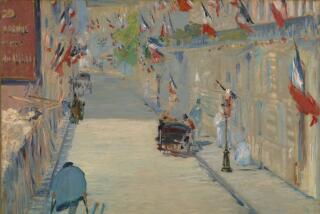WILSHIRE CENTER
- Share via
A contemporary of Toulouse-Lautrec, Signac and Bonnard, Henri Riviere (1864-1951) is best known as an innovative printmaker and among the first artists to work extensively in color lithography. Producing the bulk of his graphic work between 1890 and 1910, Riviere combined the Barbizon and Impressionist schools’ predilection for natural light and harmonious landscape with the stylistic and structural anomalies of “Japonisme.”
Although Riviere’s artistic career began as creator and director of the silhouette puppet theater at Montmartre’s “Chat Noir” cabaret, he eschewed the Bohemian life style of his early cohorts and quickly established his reputation through lithographs, woodcuts and watercolors that owed heavy debts to the landscape prints of Hokusai and Hiroshige. Rather than merely imitate these Ukiyo-e masters, however, Riviere fused their pictorial vocabulary with that inimitably French reverence for the spiritually nourishing landscape and the hard labor of the common man, typified by the works of Millet.
Riviere’s muted, almost pastel depictions of the Breton countryside and coastline, with their stoically bent figures communing with the forces of nature; as well as his panoramas of an increasingly industrialized Paris (he manages to imbue the Eiffel Tower with all the mystic presence of Mt. Fuji), subvert Renaissance perspective and horizontal composition in favor of predominantly diagonal spacial parameters. High horizon lines accentuate depth of field, exacerbated by layered blocking devices such as trees and hillsides. Truncated objects and oblique angles, so typical of Hokusai, undermine the autonomy of the rectangular frame and allude to a wider space outside the picture plane.
Although our reading of the work is prejudiced by the debasement of the print genre by the design industry (e.g., Ukiyo-e Christmas cards), it takes only a slight critical readjustment to see these works not as decorative indulgences of La Belle Epoch, but rather as part of a wider, radical structural movement that anticipates Modernism, encompassing the oeuvre of such masters as Manet and Degas. (Jack Rutberg Fine Arts, 357 N. La Brea Ave., to June 7.)
More to Read
The biggest entertainment stories
Get our big stories about Hollywood, film, television, music, arts, culture and more right in your inbox as soon as they publish.
You may occasionally receive promotional content from the Los Angeles Times.










